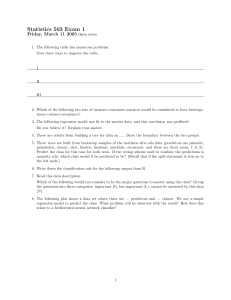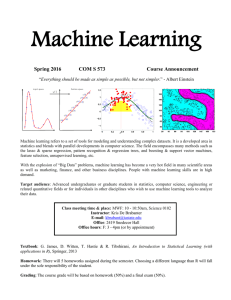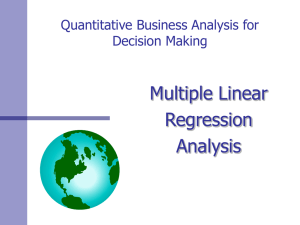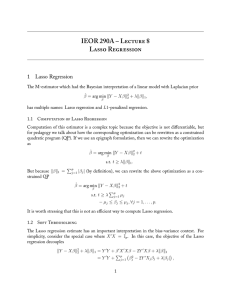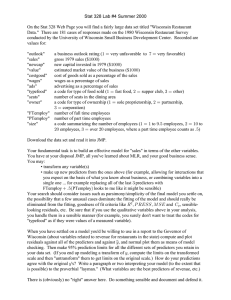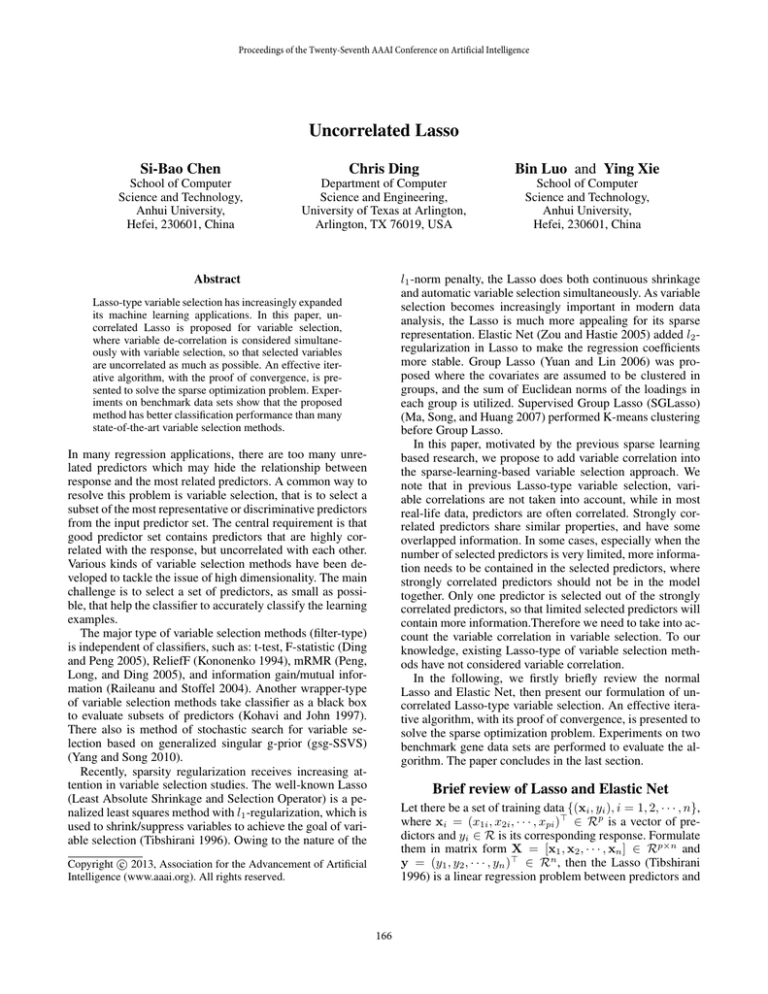
Proceedings of the Twenty-Seventh AAAI Conference on Artificial Intelligence
Uncorrelated Lasso
Si-Bao Chen
Chris Ding
Bin Luo and Ying Xie
School of Computer
Science and Technology,
Anhui University,
Hefei, 230601, China
Department of Computer
Science and Engineering,
University of Texas at Arlington,
Arlington, TX 76019, USA
School of Computer
Science and Technology,
Anhui University,
Hefei, 230601, China
l1 -norm penalty, the Lasso does both continuous shrinkage
and automatic variable selection simultaneously. As variable
selection becomes increasingly important in modern data
analysis, the Lasso is much more appealing for its sparse
representation. Elastic Net (Zou and Hastie 2005) added l2 regularization in Lasso to make the regression coefficients
more stable. Group Lasso (Yuan and Lin 2006) was proposed where the covariates are assumed to be clustered in
groups, and the sum of Euclidean norms of the loadings in
each group is utilized. Supervised Group Lasso (SGLasso)
(Ma, Song, and Huang 2007) performed K-means clustering
before Group Lasso.
In this paper, motivated by the previous sparse learning
based research, we propose to add variable correlation into
the sparse-learning-based variable selection approach. We
note that in previous Lasso-type variable selection, variable correlations are not taken into account, while in most
real-life data, predictors are often correlated. Strongly correlated predictors share similar properties, and have some
overlapped information. In some cases, especially when the
number of selected predictors is very limited, more information needs to be contained in the selected predictors, where
strongly correlated predictors should not be in the model
together. Only one predictor is selected out of the strongly
correlated predictors, so that limited selected predictors will
contain more information.Therefore we need to take into account the variable correlation in variable selection. To our
knowledge, existing Lasso-type of variable selection methods have not considered variable correlation.
In the following, we firstly briefly review the normal
Lasso and Elastic Net, then present our formulation of uncorrelated Lasso-type variable selection. An effective iterative algorithm, with its proof of convergence, is presented to
solve the sparse optimization problem. Experiments on two
benchmark gene data sets are performed to evaluate the algorithm. The paper concludes in the last section.
Abstract
Lasso-type variable selection has increasingly expanded
its machine learning applications. In this paper, uncorrelated Lasso is proposed for variable selection,
where variable de-correlation is considered simultaneously with variable selection, so that selected variables
are uncorrelated as much as possible. An effective iterative algorithm, with the proof of convergence, is presented to solve the sparse optimization problem. Experiments on benchmark data sets show that the proposed
method has better classification performance than many
state-of-the-art variable selection methods.
In many regression applications, there are too many unrelated predictors which may hide the relationship between
response and the most related predictors. A common way to
resolve this problem is variable selection, that is to select a
subset of the most representative or discriminative predictors
from the input predictor set. The central requirement is that
good predictor set contains predictors that are highly correlated with the response, but uncorrelated with each other.
Various kinds of variable selection methods have been developed to tackle the issue of high dimensionality. The main
challenge is to select a set of predictors, as small as possible, that help the classifier to accurately classify the learning
examples.
The major type of variable selection methods (filter-type)
is independent of classifiers, such as: t-test, F-statistic (Ding
and Peng 2005), ReliefF (Kononenko 1994), mRMR (Peng,
Long, and Ding 2005), and information gain/mutual information (Raileanu and Stoffel 2004). Another wrapper-type
of variable selection methods take classifier as a black box
to evaluate subsets of predictors (Kohavi and John 1997).
There also is method of stochastic search for variable selection based on generalized singular g-prior (gsg-SSVS)
(Yang and Song 2010).
Recently, sparsity regularization receives increasing attention in variable selection studies. The well-known Lasso
(Least Absolute Shrinkage and Selection Operator) is a penalized least squares method with l1 -regularization, which is
used to shrink/suppress variables to achieve the goal of variable selection (Tibshirani 1996). Owing to the nature of the
Brief review of Lasso and Elastic Net
Let there be a set of training data {(xi , yi ), i = 1, 2, · · · , n},
where xi = (x1i , x2i , · · · , xpi )> ∈ Rp is a vector of predictors and yi ∈ R is its corresponding response. Formulate
them in matrix form X = [x1 , x2 , · · · , xn ] ∈ Rp×n and
y = (y1 , y2 , · · · , yn )> ∈ Rn , then the Lasso (Tibshirani
1996) is a linear regression problem between predictors and
c 2013, Association for the Advancement of Artificial
Copyright Intelligence (www.aaai.org). All rights reserved.
166
where
response, which can be written as
minp ky> − β > Xk22 + λkβk1 ,
β∈R
C=RR
(5)
2
is the square correlation coefficient matrix, ckl = rkl . is
Hadamard product of matrices. We choose C instead of R
to eliminate the effect of anti-correlation.
Therefore, we combine the above two minimization problem of Lasso (1) and decorrelation (4), and propose uncorrelated Lasso (ULasso) for representation and variable selection, which is formulated as
(1)
where kβk1 is l1 -norm
Pp of vector β (sum of absolute elements), kβk1 =
j=1 |βj |. λ ≥ 0 is a tuning parameter. An intercept term is often omitted from (1) if the response and the predictors have been preprocessed by zero
centering. The solution vector of (1) is very sparse (with
few nonzero elements) due to the l1 -norm penalty. However,
l1 -minimization algorithm is not stable compared with l2 minimization (Xu, Caramanis, and Mannor 2012).
The Elastic Net (Zou and Hastie 2005) adds l2 minimization term into Lasso objective function, which can
be formulated as
min ky> − β > Xk22 + λ1 kβk1 + λ2 kβk22 ,
β∈Rp
min ky> − β > Xk22 + λ1 kβk1 + λ2 β > Cβ,
β∈Rp
where λ1 , λ2 ≥ 0 are tuning parameters. Note that correlation coefficient matrix R is semi-positive, then C is semipositive. Therefore, Equation (6) is a convex optimization
because all three terms are convex, which indicates that there
exists a unique global optimum solution for minimizing (6)
of ULasso.
By minimizing formula (6), one can obtain regression
coefficients not only as sparse as that of Lasso but also
with nonzero elements corresponding to predictors containing minimal correlations. If parameter λ2 in (6) is set to be
zero, then ULasso is reduced to normal Lasso. If the original
predictors are all uncorrelated, i.e., C = Ip , then ULasso is
turned into Elastic Net.
(2)
where λ1 , λ2 ≥ 0 are tuning parameters. Apart from enjoying a similar sparsity of representation of Lasso, the Elastic
Net encourages a grouping effect, where strongly correlated
predictors tend to be in or out of the model together (Zou
and Hastie 2005).
Predictors with high correlation contain similar properties, and have some overlapped information. In some
cases, especially when the number of selected predictors
is very limited, more information needs to be contained in
the selected predictors, where strongly correlated predictors
should not be in the model together. Only one predictor is
selected out of the strongly correlated predictors, so that limited selected predictors will contain more information.
Optimization Algorithm
To obtain the global minimization solution of (6), we propose an iterative algorithm, which can be summarized as in
Algorithm 1. In each iteration step, diagonal matrix M is
calculated with the current β as in formula (7), and then β
is updated based on the just calculated M as in formula (8).
The iteration procedure between (7) and (8) is repeated until
the algorithm converges.
Uncorrelated Lasso
In this section, we consider the variable selection based on
Lasso-type l1 -minimization where selected predictors are
uncorrelated as much as possible. Only one predictor of
strongly correlated predictors tend to be in the model while
the others not.
Algorithm 1 Procedure of Uncorrelated Lasso
1: Input: Predictor matrix X ∈ Rp×n and corresponding
response y ∈ Rn (response and all p predictors are zeromean and unit variance), initial regression coefficients
β (0) ∈ Rp , tuning parameters λ1 , λ2 ≥ 0, maximum
number of iteration tmax or residual bound > 0;
2: Compute fixed matrix B = XX> + λ2 C, t = 0;
3: Update diagonal matrix
q
q
q
(t)
(t)
(t)
|β1 |, |β2 |, · · · , |βp | ; (7)
M(t) = diag
The Formulation
Suppose there are the matrix of predictors with n observations of p predictors X = [x1 , x2 , · · · , xn ] =
(xki ) ∈ Rp×n and the corresponding response vector y =
(y1 , y2 , · · · , yn )> ∈ Rn . Suppose response and all p predictors are preprocessed by normalization of zero mean and
unit variance.
Denote the correlation coefficient matrix of p predictors
R = (rkl ) ∈ [−1, 1]p×p , where the (k, l)-th element rkl
is the correlation coefficient between the k and l-th zerocentered predictors,
Pn
xki xli
rkl = pPn i=12 pPn
.
(3)
2
x
i=1 ki
i=1 xli
4: Update regression coefficients
−1
λ1
β (t+1) = M(t) M(t) BM(t) + Ip
M(t) Xy;
2
(8)
5: If t > tmax or kβ (t+1) − β (t) k < , go to step 6, otherwise, let t = t + 1 and go to step 3;
6: Output: The optimal regression coefficients β ∗ =
β (t+1) .
To let the selected predictors of Lasso-type l1 minimization be uncorrelated as much as possible, the regression coefficient vector β should satisfy
minp β > Cβ,
β∈R
(6)
Note that in the input data of Algorithm 1, response and
all p predictors are preprocessed by regularization of zero-
(4)
167
The solution (14) gives the global optima of G(β). Thus
G(β ∗ ) ≤ G(β) for any β. In particular, G(β ∗ ) ≤ G(β (t) ).
Comparing (8) with (14), β (t+1) = β ∗ . This completes the
proof of Lemma 2.
mean and unit variance. However, as discussed later, only
the zero centering for each predictors is essential for Algorithm 1. Regularization of unit variance for predictors is used
to balance among predictors which have different scales and
variations, so that all predictors are treated equally when
performing variable selection after Algorithm 1. Preprocessing of zero-mean and unit variance for response is optional,
which is just adopted to simplify the prediction. In two-class
case, decision bound of prediction can be simply set as zero.
It is important to note that we use Eq.(14) instead of the
seemingly simpler Eq.(13). This is because as iteration progresses, some elements of β could become zero due to the
sparsity of l1 -penalty. This causes the failure of inverse operator of M(t) in Eq.(13). Thus Eq.(13) is ill defined. However, matrix M(t) is well-defined. Thus Eq.(14) is welldefined, which is chosen as the updating rule (8) in Algorithm 1.
Justification
In this section, we will see that Algorithm 1 does converge
to the unique global optimum solution of ULasso minimization problem (6). Let L(β) denote the objective function of
ULasso in (6). Since L(β) is a convex function of regression
coefficients β, therefore, we only need to prove the objective
function value L(β) is non-increasing along each iterations
in Algorithm 1, which is summarized in Theorem 1.
Lemma 3 The {β (t) , t = 0, 1, 2, · · ·} sequence obtained by
iteratively computing (7) and (8) in Algorithm 1 has the following property
L(β (t+1) ) − L(β (t) ) ≤ G(β (t+1) ) − G(β (t) ).
(t+1)
Proof Setting ∆ = (L(β
) − L(β
G(β (t) )), substitute (6) and (9) in it,
Theorem 1 The objective function value L(β) in ULasso
minimization problem (6) is non-increasing, L(β t+1 ) ≤
L(β t ), along with each iteration of formulae (7) and (8) in
Algorithm 1.
∆
To prove the Theorem 1, we need the help of the following
two Lemmas, which are needed to be proved firstly.
Lemma 2 Define an auxiliary function
G(β) = ky> − β > Xk22 + λ1
p
X
βj2
(t)
j=1 2|βj |
)) − (G(β
(15)
(t+1)
)−
(λ1 kβ (t+1) k1 − λ1 kβ (t) k1 ) −
(t)
(t+1) 2
p
p
X
X
(βj )2
(βj
)
λ1
− λ1
(t)
(t)
j=1 2|βj |
j=1 2|βj |
p
λ1 X 1
(t+1)
(t)
(t)
= −
{−2|βj
||βj | + 2|βj |2 +
2 j=1 |β (t) |
j
+ λ2 β > Cβ. (9)
(t+1) 2
(t)
) − (βj )2 }
p
2
λ1 X 1 (t+1)
(t)
= −
|β
|
−
|β
|
j
j
2 j=1 |β (t) |
j
(βj
(t)
Along with the {β , t = 0, 1, 2, · · ·} sequence obtained in
Algorithm 1, the following inequality holds,
G(β (t+1) ) ≤ G(β (t) ).
=
(t)
(10)
≤ 0.
Proof Since all three terms in auxiliary function G(β) are
semi-definite programming (SDP) problems, we can obtain
the global optimal solution of G(β) by taking the derivatives
and let them equal to zero.
Making use of M(t) denotation in (7), the auxiliary function G(β) can be rewritten as
(16)
This completes the proof of Lemma 3.
From Lemma 2 and Lemma 3, we have,
L(β (t+1) ) − L(β (t) ) ≤ G(β (t+1) ) − G(β (t) ) ≤ 0, (17)
which is to say
λ1
G(β) = ky> − β > Xk22 + β > (M(t) )−2 β + λ2 β > Cβ.
2
(11)
Take the derivative of (11) with respect to β, and we get
L(β (t+1) ) ≤ L(β (t) ).
(18)
This completes the proof of Theorem 1. Therefore, Algorithm 1 converges to the global optimal solution of minimizing (6) of ULasso.
∂G(β)
λ1
= 2XX> β − 2Xy + 2(M(t) )−2 β + λ2 2Cβ.
∂β
2
(12)
By setting ∂G(β)
=
0,
we
obtain
the
optimal
solution
of
∂β
auxiliary function
−1
λ1
∗
>
(t) −2
β
=
XX + (M ) + λ2 C
Xy (13)
2
−1
λ1
=
B + (M(t) )−2
Xy
2
−1
λ1
(t)
(t)
(t)
= M
M BM + Ip
M(t) Xy.(14)
2
Variable Selection
When the global optimal solution β ∗ = (β1∗ , β2∗ , · · · , βp∗ )>
of ULasso objective function (6) is obtain by Algorithm
1, small regression coefficients βj∗ are treated as zero for
variable selection. Denote the filtered coefficients be β̂ =
(β̂1 , β̂2 , · · · , β̂p )> ,
βj∗ , if |βj∗ | > µ
,
(19)
0,
if |βj∗ | ≤ µ
Pp
where > 0 is a small constant and µ = j=1 |βj∗ |/p is absolute mean coefficient. Suppose there are k nonzero filtered
β̂j = {
168
coefficients |β̂j1 | ≥ |β̂j2 | ≥ · · · ≥ |β̂jk | > 0, then those predictors indexed by {j1 , j2 , · · · , jk } are selected out.
In cases where different number of predictors need to be
selected out, one should tune parameters λ1 and λ2 in objective function (6) to obtain different sparsity of filtered
regression coefficients β̂. A suboptimal but much simpler
method of selecting q predictors is just picking out those predictors indexed by {j1 , j2 , · · · , jq }, which are corresponding to the q biggest absolute filtered regression coefficients
{β̂j1 , β̂j2 , · · · , β̂jq }.
where diagonal matrix M is defined as in (7). Taking the
derivative of G(t, β) with respect to t and β, and letting them
equal to zero, one can obtain
1
t = (y> − β > X)1n ,
(25)
n
−1
λ1
X(y − t1n ). (26)
β = XX> + M−2 + λ2 C
2
From (25), we can get
X(y − t1n )
Prediction Bound: Two-Class Case
Suppose q predictors {xj1 , xj2 , · · · , xjq } are selected out,
then the regression coefficients between q selected predictors and response needs to be recalculated with normal
least-square method. Denote selected predictor vector x0 =
(xj1 , xj2 , · · · , xjq )> , its corresponding observation matrix
X0 = [x01 , x02 , · · · , x0n ]. The coefficients β 0 of regression
equation y> = β 0> X0 is re-estimated as
β̂ 0 = (X0 X0> )−1 X0 y.
The response of new observed predictor vector x
(xj1 , xj2 , · · · , xjq )> can be predicted by
ŷ = β̂ 0> x0 .
= X̃y + XPX> β,
where P =
In − P.
1
>
n 1n 1n ,
(27)
2
it satisfies P = P and (In − P)2 =
>
X̃=X(I
ˆ
n − P) = X − x̄1n
(28)
is the zero-centered predictor matrix.
Now replace (27) into (26), and we obtain
−1
λ1 −2
∗
>
β
=
X(In − P)X + M + λ2 C
X̃y
2
−1
λ1
X̃y
=
X̃X̃> + M−2 + λ2 C
2
−1
λ1
= M MB̃M + Ip
MX̃y,
(29)
2
(20)
0
1
>
1n 1>
n (y − X β))
n
= X((In − P)y + PX> β)
= X(y −
=
(21)
When response y is label information of two classes y ∈
{−1, 1}, the Bayesian optimal decision bound can be obtained as follows. Let all training samples of the two classes
estimate their responses via formula (21), and denote the
means and standard deviations of the estimated responses
of the two classes be ȳ1 , ȳ2 and σ1 , σ2 . Then, at Bayesian
optimal decision bound b, the probability density of the two
classes should be equal, p(b|ȳ1 , σ1 ) = p(b|ȳ2 , σ2 ), which is
equivalent to (b − ȳ1 )/σ1 = (ȳ2 − b)/σ2 . This gives the
Bayesian optimal decision bound b,
σ2 ȳ1 + σ1 ȳ2
b=
.
(22)
σ1 + σ2
where B̃ = X̃X̃> + λ2 C. Comparing (29) with (8), we
can see that the iteration procedure of ULasso with intercept
term is similar to Algorithm 1, which needs to convert predictor matrix X to zero-centered X̃ as (28) before iteration,
then alternately update M and β as (7) and (29). As the iteration procedure converges, the intercept term t is estimated
as (25), or
t∗ = ȳ − β ∗> x̄,
(30)
Pn
Pn
where ȳ = i=1 yi and x̄ = i=1 xi are average response
and average predictor vector of training samples.
For new observed predictor vector x0 , its response ŷ is predicted by (21). If ŷ < b, then make decision that x0 belongs
to class 1; otherwise, class 2.
Coefficient Initialization
Intercept Term
From Theorem 1 we know that Algorithm 1 can converges
to the global optimal solution from any nonzero initial coefficient β (0) . However, different coefficient initialization may
affect the convergence speed of Algorithm 1.
To evaluate the effect of different initial coefficient β (0)
on the convergence speed of Algorithm 1, we design five
initial coefficient β (0) : first, all p entries are uniform random
number between 0 and 1; second, all p entries are Gaussian
random number of zero-mean and unit-variance; third, all p
entries are equal to p1 ; fourth, least square coefficient β (0) =
(XX> + λ2 C)−1 Xy; and fifth, ridge regression coefficient
β (0) = (XX> + Ip )−1 Xy.
These five coefficient initializations are tested on Colon
Cancer Data ((Alon et al. 1999)). Figure 1 shows the variation of objective function value along with each iteration
If predictors are not zero centered, then the intercept term
t can not be omitted from the objective function (6) of
ULasso. The formal objective function with intercept term
t of ULasso, for any predictors X = [x1 , x2 , · · · , xn ] =
(xji ) ∈ Rp×n and response y = (y1 , y2 , · · · , yn )> ∈ Rn
without preprocessing, can be written as
>
2
>
min ky> − t1>
n − β Xk2 + λ1 kβk1 + λ2 β Cβ, (23)
β∈Rp
where 1n is an n-dimensional vector with all one entry.
Similar to previous method, an auxiliary function is constructed
λ1 > −2
>
2
G(t, β) = ky> −t1>
β M β +λ2 β > Cβ,
n −β Xk2 +
2
(24)
169
Figure 1: Effect of different initial regression coefficient.
Figure 2: External LOOCV classification accuracy of
ULasso on Colon Cancer Data.
steps when different initial coefficient is adopted in Algorithm 1. From the figure we can see that Algorithm 1 converges very quickly, whatever the initial coefficient. The
lines corresponding to the first three initializations are very
similar and converge almost the same time. Initialization
with least square coefficient is a little slower than other
initializations. The fastest convergence is corresponding to
the initialization with ridge regression coefficient, since it is
closer to the optimal solution.
4) these q genes were used to classify the left out sample.
This process was repeated for all observations in the training
set until each observation had been picked out and classified
exactly once.
Based on the LOOCV strategy, the classification performance of our method, with different q genes selected out,
is plotted in Figure 2. From the figure, we can see that the
performances of all three methods, Lasso, Elastic Net and
ULasso, become better as more genes are picked out for
classification. When the number of genes becomes large,
the classification performances begin to saturate. When the
number of genes is fixed, the performance of Elastic Net is
comparable to Lasso. However, the proposed ULasso show
consistent superiority over the Lasso and Elastic Net.
The top classification accuracy and the corresponding
number of genes of the proposed ULasso are compared
with the following classification methods: SVM (Furey et
al. 2000), LogitBoost (Dettling and Bhlmann 2003), MAVELD (Antoniadis, Lambert-Lacroix, and Leblanc 2003), gsgSSVS (Yang and Song 2010), Supervised group Lasso
(SGLasso) (Ma, Song, and Huang 2007), Lasso (Tibshirani
1996) and Elastic Net (Zou and Hastie 2005). The summary
is presented in Table 1. It is clear from the comparison that
the proposed ULasso is better than the other popular classification methods using only moderate number of genes.
Experiments
We evaluate the effectiveness of the proposed uncorrelated
Lasso (ULasso) on two well known data sets: the Colon
Cancer Data (Alon et al. 1999) and the Leukemia Dataset
(Golub et al. 1999). The performance in variable selection
and classification accuracy of the ULasso will be compared
with other methods.
Colon Cancer Data
Alon et al. used Affymetrix Oligonucleotide Array to
measure expression levels of 40 tumor and 22 normal
colon tissues for 6500 human genes (Alon et al. 1999).
These samples were collected from 40 different colon
cancer patients, in which 22 patients supplied both normal and tumor samples. A subset of 2000 genes based
on highest minimal intensity across the samples was selected, which can be downloaded from http:// microarray.princeton.edu/oncology/affydata/. These data are preprocessed by taking a base 10 logarithmic of each expression level, and then each tissue sample is standardized to
zero mean and unit variance across the genes.
Since this dataset does not contain test set, leave-one-out
cross validation (LOOCV) is usually adopted to evaluate the
performance of the classification methods for a selected subset of genes. The external LOOCV procedure is performed
as follows: 1) omit one observation of the training set; 2)
based on the remaining observations, reduce the set of available genes to the top 200 genes as ranked in terms of the
t statistic; 3) the q most significant genes were re-chosen
from the 200 genes by the proposed ULasso algorithm; and
Method
SVM
LogitBoost, optimal
MAVE-LD
gsg-SSVS
SGLasso
Lasso
Elastic Net
ULasso
No. of genes
1000 or 2000
2000
50
10/14
19
6
13
12
LOOCV accuracy
0.9032
0.8710
0.8387
0.8871
0.8710
0.8710
0.8710
0.9355
Table 1: Top LOOCV accuracy and corresponding number
of genes on Colon Cancer Data.
170
Figure 3: Classification accuracy of ULasso on Leukemia
training set.
Figure 4: Classification accuracy of ULasso on Leukemia
testing set.
Leukemia Dataset
genes are summarized in Table 2. From the table we can see
that the proposed ULasso outperforms other methods with
moderate number of genes.
The leukaemia data consist of 7129 genes and 72 samples (Golub et al. 1999), which can be downloaded from
http://www.broad.mit.edu/cgi-bin/cancer/datasets.cgi. In the
training data set, there are 38 samples, among which 27 are
type 1 leukaemia (acute lymphoblastic leukaemia, ALL) and
11 are type 2 leukaemia (acute myeloid leukaemia, AML).
The remaining 34 samples constitute test set, among which
20 are ALL and 14 are AML.
The preprocess method suggested by (Dudoit, Fridlyand,
and Speed 2002) is taken for the data: 1) thresholding:
floor of 100 and ceiling at 16, 000; 2) filtering: retain genes
with max(gene)/ min(gene) > 5 and (max(gene) −
min(gene)) > 500, where max(gene) and min(gene) refer
to the maximum and minimum expression levels of a particular gene across samples respectively; and 3) base 10 logarithmic transformation. The filtering resulted in 3571 genes.
The gene expression data are further preprocessed to have
mean zero and variance one across samples.
The gene selection procedure of our ULasso and other
methods is trained on the training set. When a subset of
genes are selected out for each methods, classification is performed both in training set and test set. Figure 3 and Figure
4 show the classification accuracy results of ULasso, compared with Lasso and Elastic Net, on Leukemia training and
testing sets when different number of genes are selected.
From the figures we can see that all of the three methods
perform excellent on training set (all classify correct). On
test set, Elastic Net is comparable to Lasso with the same
number of genes selected out. Our proposed ULasso consistently outperforms the other two methods.
Then the top classification results of the proposed ULasso
is compared with SVM (Furey et al. 2000), weighted voting machine (WVM) (Golub et al. 1999), MAVE-LD (Antoniadis, Lambert-Lacroix, and Leblanc 2003), gsg-SSVS
(Yang and Song 2010), Lasso (Tibshirani 1996) and Elastic Net (Zou and Hastie 2005). The classification accuracy
on training set and test set, and the corresponding number of
Method
SVM
WVM
MAVE-LD
gsg-SSVS
Lasso
Elastic Net
ULasso
No. of genes
25∼2000
50
50
14
21
26
22
Training
accuracy
0.9474
0.9474
0.9737
0.9737
1.0000
1.0000
1.0000
Test
accuracy
0.8824∼0.9412
0.8529
0.9706
0.9706
0.9118
0.9118
1.0000
Table 2: Top accuracy and corresponding number of genes
on Leukemia Dataset.
Conclusion
Lasso-type variable selection is learned with constrains
of de-correlation, which is named uncorrelated Lasso
(ULasso), so that the variables selected out are uncorrelated
as much as possible. An effective iterative algorithm and
its corresponding analysis, with proof of convergence, are
proposed to solve ULasso. Experiments on two well known
gene datasets show that the proposed ULasso has better classification performance than many state-of-the-art variable
selection methods.
Acknowledgments
This work is supported by the Natural Science Foundation of China (61202228, 61073116), the Doctoral Program
Foundation of Institutions of Higher Education of China
(20103401120005), and Collegiate Natural Science Fund of
Anhui Province (KJ2012A004).
171
References
Yuan, M., and Lin, Y. 2006. Model selection and estimation in regression with grouped variables. Journal of the
Royal Statistical Society: Series B (Statistical Methodology)
68(1):49–67.
Zou, H., and Hastie, T. 2005. Regularization and variable
selection via the elastic net. Journal of the Royal Statistical
Society: Series B (Statistical Methodology) 67(2):301–320.
Alon, U.; Barkai, N.; Notterman, D.; Gish, K.; Ybarra, S.;
Mack, D.; and Levine, A. 1999. Broad patterns of gene expression revealed by clustering analysis of tumor and normal
colon tissues probed by oligonucleotide arrays. Proceedings
of the National Academy of Sciences 96(12):6745–6750.
Antoniadis, A.; Lambert-Lacroix, S.; and Leblanc, F. 2003.
Effective dimension reduction methods for tumor classification using gene expression data. Bioinformatics 19(5):563–
570.
Dettling, M., and Bhlmann, P. 2003. Boosting for tumor classification with gene expression data. Bioinformatics
19(9):1061–1069.
Ding, C. H. Q., and Peng, H. 2005. Minimum redundancy
feature selection from microarray gene expression data. J.
Bioinformatics and Computational Biology 3(2):185–206.
Dudoit, S.; Fridlyand, J.; and Speed, T. P. 2002. Comparison of discrimination methods for the classification of tumors using gene expression data. Journal Of The American
Statistical Association 97(457):77–87.
Furey, T. S.; Cristianini, N.; Duffy, N.; Bednarski, D. W.;
Schummer, M.; and Haussler, D. 2000. Support vector
machine classification and validation of cancer tissue samples using microarray expression data. BMC Bioinformatics
16(10):906–914.
Golub, T. R.; Slonim, D. K.; Tamayo, P.; Huard, C.; Gaasenbeek, M.; Mesirov, J. P.; Coller, H.; Loh, M. L.; Downing,
J. R.; Caligiuri, M. A.; and et al. 1999. Molecular classification of cancer: class discovery and class prediction by gene
expression monitoring. Science 286(5439):531–537.
Kohavi, R., and John, G. H. 1997. Wrappers for feature
subset selection. Artif. Intell. 97(1-2):273–324.
Kononenko, I. 1994. Estimating attributes: Analysis and
extensions of RELIEF. In European Conference on Machine
Learning, 171–182.
Ma, S.; Song, X.; and Huang, J. 2007. Supervised group
lasso with applications to microarray data analysis. BMC
Bioinformatics 8.
Peng, H.; Long, F.; and Ding, C. H. Q. 2005. Feature
selection based on mutual information: Criteria of maxdependency, max-relevance, and min-redundancy. IEEE
Trans. Pattern Anal. Mach. Intell. 27(8):1226–1238.
Raileanu, L. E., and Stoffel, K. 2004. Theoretical comparison between the gini index and information gain criteria.
Ann. Math. Artif. Intell. 41(1):77–93.
Tibshirani, R. 1996. Regression shrinkage and selection via
the Lasso. Journal of the Royal Statistical Society. Series B
(Methodological) 58(1):267–288.
Xu, H.; Caramanis, C.; and Mannor, S. 2012. Sparse algorithms are not stable: A no-free-lunch theorem. IEEE Trans.
Pattern Anal. Mach. Intell. 34(1):187–193.
Yang, A.-J., and Song, X.-Y. 2010. Bayesian variable selection for disease classification using gene expression data.
Bioinformatics 26(2):215–222.
172

